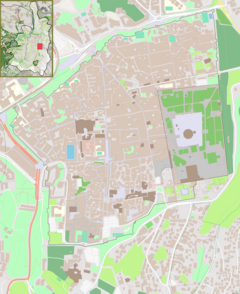
Back Tweede Tempel Afrikaans الهيكل الثاني Arabic الهيكل التانى ARZ İkinci məbəd Azerbaijani Втори йерусалимски храм Bulgarian দ্বিতীয় মন্দির Bengali/Bangla Segon Temple Catalan Druhý chrám Czech Det Andet Tempel Danish Herodianischer Tempel German
| Second Temple Herod's Temple | |
|---|---|
בֵּית־הַמִּקְדָּשׁ הַשֵּׁנִי | |
 Model of Herod's Temple (inspired by the writings of Josephus) displayed within the Holyland Model of Jerusalem at the Israel Museum | |
| Religion | |
| Affiliation | Judaism |
| Region | Land of Israel |
| Deity | Yahweh |
| Leadership | High Priest of Israel |
| Location | |
| Location | Temple Mount |
| Municipality | Jerusalem |
| State | Yehud Medinata (first) Judaea (last) |
| Country | Achaemenid Empire (first) Roman Empire (last) |
Location within the Old City of Jerusalem Location within Jerusalem (modern municipal borders) Location within the State of Israel | |
| Geographic coordinates | 31°46′41″N 35°14′7″E / 31.77806°N 35.23528°E |
| Architecture | |
| Founder | Zerubbabel; refurbished by Herod the Great |
| Completed | c. 516 BCE (original) c. 18 CE (Herodian) |
| Destroyed | 70 CE (Roman siege) |
| Specifications | |
| Height (max) | c. 46 metres (151 ft) |
| Materials | Jerusalem limestone |
| Excavation dates | 1930, 1967, 1968, 1970–1978, 1996–1999, 2007 |
| Archaeologists | Charles Warren, Benjamin Mazar, Ronny Reich, Eli Shukron, Yaakov Billig |
| Present-day site | Dome of the Rock |
| Public access | Limited; see Temple Mount entry restrictions |
The Second Temple (Hebrew: בֵּית־הַמִּקְדָּשׁ הַשֵּׁנִי Bēṯ hamMīqdāš hašŠēnī, transl. 'Second House of the Sanctum') was the reconstructed Temple in Jerusalem, in use between c. 516 BCE and its destruction in 70 CE. In its last phase it was enhanced by Herod the Great, the result being later called Herod's Temple. Defining the Second Temple period, it stood as a pivotal symbol of Jewish identity and was central to Second Temple Judaism; it was the chief place of worship, ritual sacrifice (korban), and communal gathering for Jews. As such, it attracted Jewish pilgrims from distant lands during the Three Pilgrimage Festivals: Passover, Shavuot, and Sukkot.
Construction on the Second Temple began in the aftermath of the Persian conquest of Babylon; the Second Temple's predecessor, known as Solomon's Temple, had been destroyed alongside the Kingdom of Judah as a whole by the Babylonian siege of Jerusalem around 587 BCE.[1] After the Neo-Babylonian Empire was annexed by the Achaemenid Empire, the Persian king Cyrus the Great issued the so-called Edict of Cyrus, which is described in the Hebrew Bible as having authorized and encouraged the return to Zion—a biblical event in which the Jewish people returned to the former Kingdom of Judah, which the Persians had recently restructured as the self-governing Jewish province of Yehud Medinata. The completion of the Second Temple at the time of the Persian king Darius I signified a period of renewed Jewish hope and religious revival. According to biblical sources, the Second Temple was originally a relatively modest structure built under the authority of the Persian-appointed Jewish governor Zerubbabel, the grandson of Jeconiah, the penultimate king of Judah.[2]
In the 1st century BCE, the Second Temple was refurbished and expanded under the reign of Herod the Great, hence the alternative eponymous name for the structure. Herod's transformation efforts resulted in a grand and imposing structure and courtyard, including the large edifices and façades shown in modern models, such as the Holyland Model of Jerusalem in the Israel Museum. The Temple Mount, where both Solomon's Temple and the Second Temple stood, was also significantly expanded, doubling in size to become the ancient world's largest religious sanctuary.[3]
In 70 CE, at the height of the First Jewish–Roman War, the Second Temple was destroyed by the Roman siege of Jerusalem,[a] marking a cataclysmic and transformative point in Jewish history.[4] The loss of the Second Temple prompted the development of Rabbinic Judaism, which remains the mainstream form of Jewish religious practices globally.
- ^ Schiffman, Lawrence H. (2003). Understanding Second Temple and Rabbinic Judaism. New York: KTAV Publishing House. pp. 48–49. ISBN 978-0-88125-813-4. Archived from the original on 2023-08-30. Retrieved 2019-08-19.
- ^ Ezra 6:15,16
- ^ Feissel, Denis (23 December 2010). Corpus Inscriptionum Iudaeae/Palaestinae: Volume 1 1/1: Jerusalem, Part 1: 1-704. Hannah M. Cotton, Werner Eck, Marfa Heimbach, Benjamin Isaac, Alla Kushnir-Stein, Haggai Misgav. Berlin: De Gruyter. p. 41. ISBN 978-3-11-174100-0. OCLC 840438627.
- ^ Karesh, Sara E. (2006). Encyclopedia of Judaism. Facts On File. ISBN 978-1-78785-171-9. OCLC 1162305378.
Until the modern period, the destruction of the Temple was the most cataclysmic moment in the history of the Jewish people. [...] The sage Yochanan ben Zakkai, with permission from Rome, set up the outpost of Yavneh to continue develop of Pharisaic, or rabbinic, Judaism.
Cite error: There are <ref group=lower-alpha> tags or {{efn}} templates on this page, but the references will not show without a {{reflist|group=lower-alpha}} template or {{notelist}} template (see the help page).


